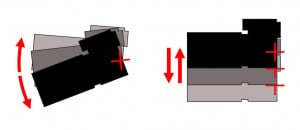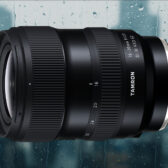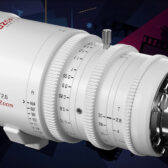
TOKYO, July 22, 2009  Canon Inc. announced today the development of Hybrid Image Stabilizer (IS), the world’s first* optical Image Stabilizer which compensates for both angular camera shake and shift camera shake. The technology will be incorporated in an interchangeable single lens reflex (SLR) camera lens planned for commercial release before the end of 2009.
Several different preventative methods and corrective procedures have been introduced to compensate for errors caused by camera shake. Canon began researching methods to compensate for camera shake in the 1980s. In 1995 Canon launched the EF 75-300mm f/4-5.6 IS USM, the world’s first interchangeable SLR camera lens to feature a mechanism that compensates for optical camera shake. Since then, the company has continued to produce a variety of interchangeable lenses with image stabilisation capabilities, and boasts a total of 21 such lenses in its current product lineup, including the EF 200mm f/2L IS USM which features up to 5-stops of blur correction.
Canon’s newly developed Hybrid IS technology optimally compensates for angular camera shake (rotational) and shift camera shake (linear). Sudden changes in camera angle can cause significant blur in images taken during standard shooting, whereas blur caused by shift-based shaking, when a camera moves parallel to the subject, is more pronounced in macro and other close-up photography.
The new Hybrid IS technology incorporates an angular velocity sensor that detects the extent of angular camera shake which is found in all previous optical Image Stabilizer mechanisms, as well as a new acceleration sensor that determines the amount of shift-based camera shake. Hybrid IS also employs a newly developed algorithm that combines the output of the two sensors and moves the lens elements to compensate for both types of movement. Hybrid IS dramatically enhances the effects of Image Stabilizer especially during macro shooting, which is difficult for conventional image stabilisation technologies.
Canon is actively engaged in ongoing research and development of interchangeable SLR camera lenses incorporating Hybrid IS technology, and is aiming for the early commercialisation and inclusion of the technology in a wide range of products.
* For use in interchangeable SLR camera lenses as of July 17, 2009. According to Canon research
cr
|
When you purchase through links on our site, we may earn an affiliate commission. Here's how it works. |









Neato! Put this technology in the camera! =D
that’s why 70-200 2.8 IS will be discontinued. . ,
This might explain the discontinuation of the 70-200 2.8 ??
Maybe this will be the technology in its replacement. There is a guy claiming the Western Canada Rep for canon has confirmed the 70-200 is done……
I bet this explains, with their emphasis in the article on the benefits to macro, the rumor on a 100mm f2.8 Macro with IS. I would REALLY like to see that lens. If they can keep the cost to $700-800 street, that would be a really nice lens….
I think “dude” nailed it, we’ll probably see a refresh of the 100mm EF macro with hybrid IS or maybe a totally new longer macro lens from Canon. I doubt the price will stay the same, they’ll probably put it in their L lineup before putting it consumer lenses like the 100mm macro. Fingers crossed for a 70-200mm refresh too. ;)
might go to both i know that the is in the 70 200 2.8l is is in need of an update as the f4 surpass’s it in that regard
Since more people buy the 100 2.8 over the 180L Macro, it would make sense to make a new macro L lens with this tech.
You know, you just gotta have L.
LOL
I’m hoping the 70-200 will be updated. I want to buy that lens, but I’m waiting on an update.
Same with the 24-70.
DP Review says Pentax already has this technology in camera. I just watched a video on youtube about the new Pentax K-7.
Looks like Canon is not planning to add it in camera any time soon.
Per Canon:
Hybrid IS dramatically enhances the effects of Image Stabilizer especially during macro shooting, which is difficult for conventional image stabilisation technologies.
Looks like it’s going into a macro lens first.
The reviews of the 100mm f2.8 macro say it is near L quality results (I like mine) and the last statement in the release makes me think they will put it in the current 100mm f2.8 macro.
“Canon is actively engaged in ongoing research and development of interchangeable SLR camera lenses incorporating Hybrid IS technology, and is aiming for the early commercialisation and inclusion of the technology in a wide range of products.”
Note, EARLY commercialization. I take that to mean get it into the market fast – profits are hurting. Wouldn’t the 100mm HIS outsell an L series lens? Also, they said wide range of products. That suggests to me that they are going to make this their new form of IS that will replace the IS in all of their lenses, eventually. So the 70-200 f2.8 and the 100mm f2.8 are first up… then how about a 100-400 II not too far behind. I REALLY want to get the 100-400 with hybrid IS and the latest focus technology. That would be my first L lens and one well worth the bucks.
that
s probably true, but this is the first of that technology for in lens systems. still extraordinary. now all we need to do is get Canon to use both in lens and in body stabilizers (since in lens are significantly more effective at longer focal lengths and macro) and in body will do an excellent job of covering the shorter focal lengths and wollah. nikon has to play catchup for a year, provided Canon doesn’t do something terribly stupid in implementation
Is this a hint that we’ll soon see an image stabilized macro lens? It has been my hope and dream for the longest time.
The 180mm f/3.5 macro lens is an L lens. I will like to see IS incorportaed into such a lens. But I also hope it won’t weigh like a ton of bricks.
Hopefully Canon has learnt something from their recent string of fiasco… 1D3 AF, anyone?
Unless and until Nikon introduces in-body IS, Canon is not going to introduce any change in this department.
I suspect that when they update it, that only the IS version receives an update, that might also be the time when the non-IS version is discontinued, it would make sense because they retained the non-IS because the optics were the same (or a little better) and it could be sold at a lower price, attracting greater sales, and people into the system, considering the nikon 80-200 was still several hundred dollars more expensive, not better optically and vastly inferior in terms of AF
never said the would, just that they should. I know Canon thinks they’re one of two manufacturers of cameras in the world, and nikon is just the dark side and can’t be mentioned by name, but they really need to snap out of that and realize that sony is a serious rising threat to them, and that they will never grind pentax out of the market if they keep allowing technical innovations to pass by them, especially since Canon has had so many QC issues lately
WOOOOOOOoooowww … boring.
The amplitude of the shakes have to be huge before you can make a difference between a shift and a rotation. Call me Parkinson.
Honestly, who cares if there is a distinction between shifts and rotations? For an end user, all I want is the scheme to work well and reliably. IF (and that is a BIG IF) it works as touted, it’ll take Nikon at least 5 years to play catch-up in this department. That is provided there is no leakage of trade secrets again…
That’s true if you shoot landscapes or weddings, however for macro – which we were discussing here – shift shake compensation makes a huge difference, even when you are Parkinson free.
regular is right.
Linear movements are almost negligible compared to angular.
Linear correction will make no difference except maybe very slightly at very close distances i.e. macro.
However IS on lenses like the 70-200mm f2.8 could really be improved, so any excuse to update the IS is good for me.
Also I’d love a 24-70 f2.8 IS, so please Canon bring it on.
Dear Canon,
Have you ever noticed how the 24-70 focus ring has ‘Macro’ at the end of its range? Well hurry along and include your magic macro IS on this lens.
I think we could see macro capabilities in both 24-70 and 70-200 refresh using this new HIS tech. It would make a lot of sense for Canon to do a 150 Macro L HIS 2.8.
Actually, DPR is dead wrong once again. Before the Pentax K7, the K100, K10D & the K20D all had that CCD-shift system that can rotate about the lens axis.
***
Shake Reduction
Pentax has implemented the same design of CCD-shift based Shake Reduction that we saw on the K100D. It is a slightly different design than other CCD-shift systems as it utilizes permanent magnets, ball bearings and four coils on the CCD plate giving the ability to move in x and y directions but also rotationally around the lens axis (click for diagram). Pentax are claiming between 2 and 4 stops over non-SR.
***
The innovation from Canon is that it uses a different method and uses new sensors to detect and compensate for angular camera shake, which IMHO is much harder to do.
Based on Nikon’s track record of copying Canon’s IS and in-lens ring USM, I expect Nikon fanbois to rave about this same technology after about a decade, a point where half of all Canon lenses would have had it. :P
actually putting macro on zooms makes them perofrm less well optically and focus slower. if you need occassional macro capability bu an extension tube, I have one, it works pretty well, especially with a TC behind it. If you shoot macro a lot it will be worth it to get a legit macro lens because they perform much better
I think you are right, the 70-200 IS plus the whole long list of $$$ telephoto lenses rumored as being readied for upgrade would get it.
I’m not sure though, how much difference it might make, I don’t see many problems with the current IS.
Nikon has one, and lots of unhappy buyers discovered that is ineffective when the lens gets cllose to the subject. At 5 feet or more, it gets better, but thats not why they bought it.
The problem, is that the angular correction required for close objects is way beyond the IS capability. This doesn’t matter whose system we are looking at, in-lens or in camera, it just doesn’t work at 1 ft distances.
Unless and until Cannon introduces in-body IS, Nikon is not going to introduce any change in this department
This sounds similar to the Dynamic IS they’re putting in the new camcorders. Doesn’t sound like Canon is planning an in-body version any time soon if they’re updating their lens line like this.
It’s a huge lens, the largest black lens they make, so adding IS isn’t going to make it smaller.
I’d doubt they’ll discontinue the non-IS version, it provides another price point and there peeps who don’t really need or want IS,
I’m a bit confused. Is that diagram suppose to be the mechanism, or a camera with the lens pointing left?
In other words, is the rotation along the lens axis, or more like your pointing the camera down?
If it’s along the lens axis, that’s some fancy optics.
why put IS in-body? I don’t see any advantage over IS on lenses. . .
Not sure if I understand here…..the IS will be in the camera?
No more IS lens….????
24-70L HIS …& HERS LOL but seriously the 24-70 is already an awesome all around lens. With the his my flash would stay in the bag for indoor events. As for macro I’d much like it on a new 100mm. It’s been around a long time.
My bad…..I read the last part….
Dave, the Pentax has in-camera horizon correction (which is only 1 degree). The Canon corrects angel and I don’t think the Pentax corrects changes in camera angle at all.
Yeah the Pentax doesn’t correct for angle shake, it has the Shake Reduction you described and also auto horizon correction (but only 1 degree), so DPR is mistaken if they said Pentax already has the same feature as Hybrid Image Stabilization.
I like the 100-400, use it often, but it really needs an update more than any of the other L lenses IMO.
Canon has a unique advantage with the MP-E 65mm.
In the field of plants and insects I find this lens to be unbeatable.
Almost a decade old and still amazing.
Hopefully if they do come out with a new macro lens utilizing this new technology that it will be able to have such a strong magnification like the 65mm.
The argument is that having it in body would:
1) Let it work with *any* existing lens
2) Save money because each lens wouldn’t need a separate IS system onboard.
allows for simpler and sharper optical design while still allowing for IS at wider focal lengths. It’s not an issue in telephoto’s, but it is with wide-angle lenses. Imagine a 14mm with 5 stop IS, that’s handholdable at over a second. that opens a lot of windows
I have always wondered if we might see a day where Canon puts IS in the body AND keeps it in some lenses and has the two talk to each other to give SUPER IS. I know, I am dreaming, but it seems as if you could design them to be complementary and still have the in-body IS beneficial to non-IS lenses.
Now THAT would surely put the others makers back on their heals, BUT I can only imagine how complex it would be. Not likely, I know. Maybe a maker on the fringe, without a conservative base to shock, will do synergistic IS to rock the mainstream makers like Canon and Nikon.
Where is Sony in all of this?
@canon:
yaaaaaaaaaaaaaaawwwn.
(sry. dont mean to offend anyone here, but an new IS is as unnecessary as the jonas bros)
In body and in lens IS would probably interfere with each other and the system would most likely use in less IS when available and otherwise use sensor based IS
but they make little girl’s ginies tickle!!! (spell check needed on the ginies, but what the hay)
which? the new IS or the jonas bros?
<>you’re wrong! better put this technology in the lens!!!